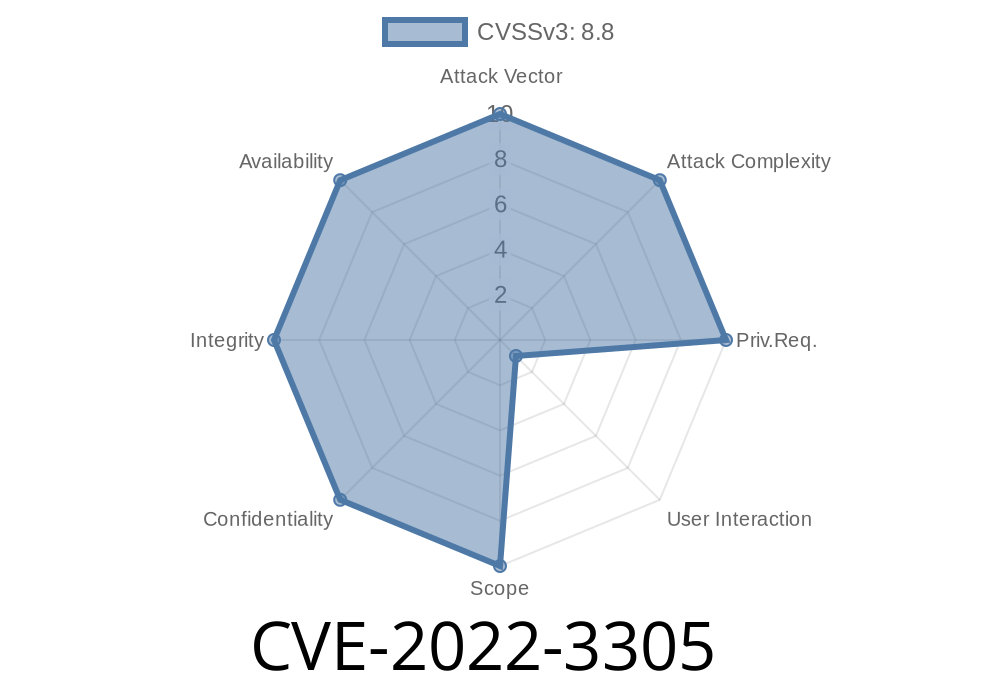Google Chrome is a widely used web browser on multiple platforms, including ChromeOS, making it an attractive target for attackers. The recent discovery of a serious security vulnerability—CVE-2022-3305—found in versions prior to 106..5249.62 of the browser has left many users concerned about the potential for unauthorized access and even system compromise. As a Chrome user, or a developer maintaining web projects, you must become familiar with this vulnerability in order to protect your personal information and secure your systems against potential exploitation. In this post, we will delve into the technical aspects of CVE-2022-3305, explore the exploit details, and review ways to mitigate or remediate this critical security issue.
Summary of CVE-2022-3305
CVE-2022-3305 refers to a high-severity use-after-free vulnerability in the survey function of Google Chrome on ChromeOS prior to the release of version 106..5249.62. An attacker exploiting this vulnerability could potentially corrupt heap memory by tricking the target user into visiting a maliciously crafted HTML page. This ultimately puts the target user and their system at risk.
Technical Breakdown
Use-after-free vulnerabilities occur when a program continues to use memory that has already been freed or released, often leading to heap corruption. In the case of CVE-2022-3305, a remote attacker who successfully corrupts the heap can gain access to sensitive information and potentially even execute arbitrary code on the affected ChromeOS system. The vulnerability specifically affects the survey function in Google Chrome, and the malicious HTML page would use this function to trigger the exploit.
Here's a simplified example depicting the use-after-free scenario
// Allocate memory for an object
MyObject* pObj = new MyObject();
// Use pObj in the survey function
Survey(pObj);
// Free the memory used by pObj
delete pObj;
// Continue to use pObj, even though its memory has been freed
pObj->SomeMethod(); // Use-after-free occurs here
In this example, when the program continues to use pObj after freeing its memory, it leads to memory corruption and the potential for exploitation by an attacker.
For more information about CVE-2022-3305, you can refer to the following original references
1. Chromium Bug Tracker: Issue 1352699: Use after free in survey
2. Chrome Release Blog Post: 106..5249.62 Google Chrome (2022-10-28)
3. National Vulnerability Database: CVE-2022-3305 Detail
Exploit Details
As previously mentioned, exploiting CVE-2022-3305 requires an attacker to craft a malicious HTML page designed to misuse the survey function in Google Chrome. By visiting the maliciously crafted page unknowingly, the victim unknowingly exposes their system to the attacker, who may then leverage heap corruption and execute arbitrary code.
Mitigation and Remediation
The most effective way to mitigate and remediate the risk presented by CVE-2022-3305 is by upgrading Google Chrome to the latest version, 106..5249.62 or later. Chrome developers are advised to actively maintain their web applications to stay up to date with the latest security patches. Users should also enable automatic updates for their Google Chrome installation to ensure they receive essential security updates as they become available.
Conclusion
CVE-2022-3305 is a high-severity vulnerability in Google Chrome on ChromeOS that has the potential to expose sensitive user information and compromise system security. To protect yourself from this dangerous exploit, ensure you update your browser as soon as possible. For developers, stay current with updates and best practices surrounding Chrome security to protect your web applications and the users who rely on them.
Timeline
Published on: 11/01/2022 20:15:00 UTC
Last modified on: 12/09/2022 15:47:00 UTC
